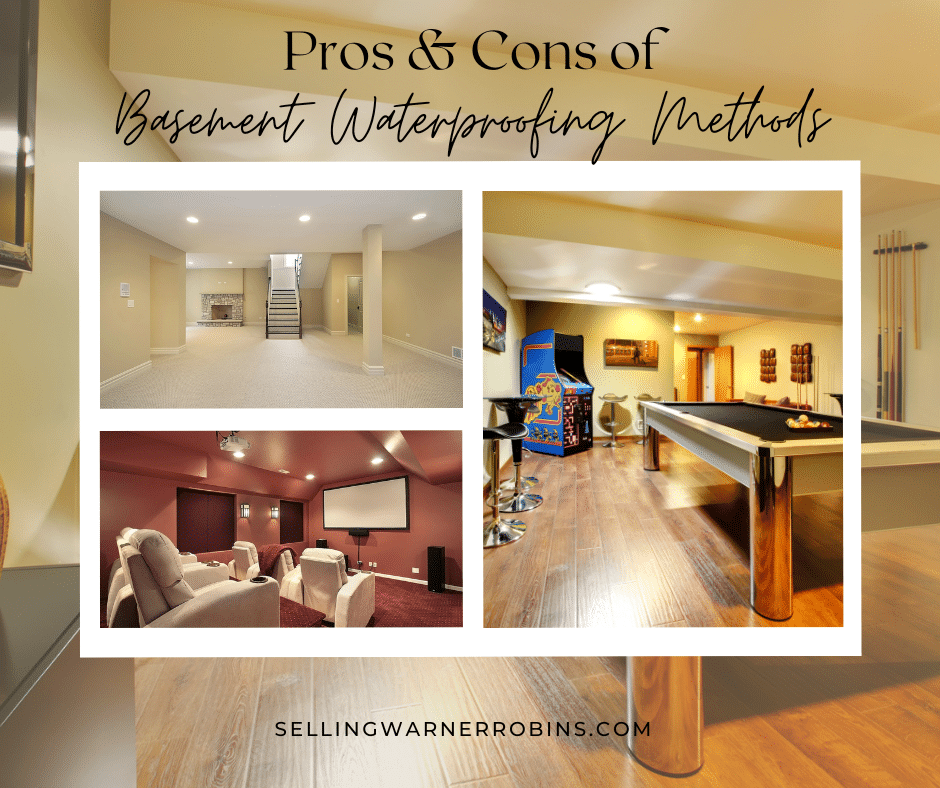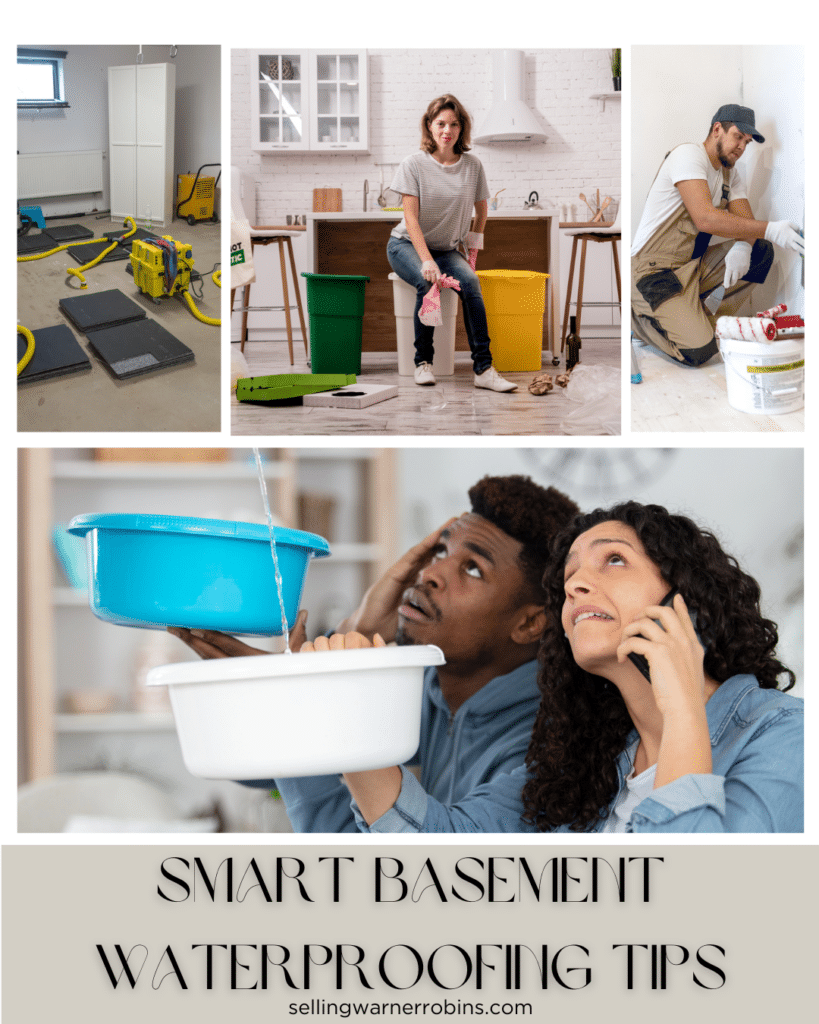Pros and Cons of Basement Waterproofing Methods
A flooded basement is a common headache for most homeowners. Different basement waterproofing methods are available to safeguard from flooding. However, these are not one-size-fits-all solutions because each basement is different. Factors such as location, the severity of water intrusion, and the type of foundation will all influence the best approach. Moreover, each method has its pros and cons, and what works well for one home might not be as effective for another.
It is important to consider both short-term and long-term results when choosing basement water solutions, as well as the cost, maintenance, and potential disruption involved. Let’s explore the most common basement waterproofing methods and their respective pros and cons to help you make a more informed decision.

What Causes Moisture in the Basement?
Before you learn the best way to waterproof a basement, it is important to figure out what causes moisture in the basement. Being aware of the sources of moisture can be quite helpful for keeping your basement dry. You can collaborate with foundation repair experts to figure out the primary cause of water in your basement. Identifying whether the issue is related to external factors like grading or internal factors like leaks is essential for a targeted approach. Addressing the source of moisture can not only prevent further damage but also improve the overall health and longevity of your home.
Here are some common causes of a wet basement.
-
Ineffective Grading
Poor grading is a common reason why water makes its way towards your basement. The ground around your home must always slope away from the foundation to ensure proper water drainage. If the grading is flat or slopes inward, water will accumulate around the foundation, eventually finding its way into your basement. In some cases, soil erosion or improperly positioned downspouts can contribute to this issue. Fixing the grading typically involves reshaping the soil or adding landscaping elements to direct water flow away from the home.
-
Defective Gutters and Downspouts
Gutters and downspouts are designed to channel rainwater away from your home’s foundation. However, if they are poorly installed, damaged, or clogged with debris, they can’t perform their job properly. Overflowing gutters or downspouts can cause water to pool around the basement, allowing it to seep in. Regular maintenance is key: clean gutters and downspouts at least twice a year, especially in the fall when leaves are likely to build up, and make sure they are properly positioned to direct water well away from the foundation.
-
Basement Cracks
Cracks in basement walls can develop over time due to a variety of factors, including foundation settlement, natural wear, or increased hydrostatic pressure. Even small cracks can allow water to seep through, especially if they are not properly sealed. It’s important to inspect your basement regularly for any signs of new or widening cracks. In some cases, cracks may also indicate deeper foundation problems that could require professional assessment and repair to prevent long-term water damage and structural issues.
-
Condensation
Condensation occurs when warm, humid air comes into contact with cooler surfaces, resulting in the formation of water droplets. In a basement, this can happen when the temperature difference between the air and basement walls or floors is significant. If your basement is poorly insulated or lacks proper ventilation, moisture buildup can lead to mold growth, wood rot, or rust. Installing a vapor barrier, improving airflow with vents or a dehumidifier, and insulating the walls and floors can help reduce condensation and prevent these issues.
-
Water Leakage
Water leakage is a common problem in basements, especially when plumbing fixtures like showers, sinks, washing machines, or dishwashers are located directly above or near the basement. Leaks in pipes, hoses, or fixtures can allow water to trickle down into the basement unnoticed, causing damage over time. Even small leaks can accumulate, leading to mold growth or structural weakening. Regularly check for leaks around pipes, especially in areas with frequent water use, and address issues promptly to prevent further damage.
-
Hydrostatic Pressure
Hydrostatic pressure occurs when the soil surrounding your foundation becomes saturated with water, typically after heavy rainfall or during seasonal changes. This pressure pushes against the foundation walls, causing cracks and allowing water to seep into the basement. The higher the water table, the more significant the hydrostatic pressure. This can be a serious issue if not addressed, as it can lead to severe damage to the foundation. Installing exterior waterproofing systems, like a French drain, or improving your home’s drainage system can help alleviate hydrostatic pressure and prevent water intrusion.
Different Basement Waterproofing Methodologies
Let’s have a look at different basement waterproofing methods, their advantages, and disadvantages.
Interior Waterproofing:
Interior basement waterproofing is required when moisture affects the inside of your basement. In other words, it mainly focuses on removing water that has already entered the basement. This method is often the first line of defense when you’re dealing with water seepage, and it can be relatively quick and cost-effective.
The process may involve installing a sump pump, interior drain tile, or applying sealants to cracks in walls and floors. In some cases, a dehumidifier may also be used to control humidity and prevent condensation buildup. While interior waterproofing can help manage existing water problems, it does not address the root cause of water intrusion, such as poor exterior grading or hydrostatic pressure, and may not be effective for severe flooding. Additionally, it may not completely stop water from entering through walls or floors, especially in areas with high water tables.
Pros:
- Cost Effectiveness:
It is cost-effective compared to other waterproofing methods and saves you from expensive foundation repairs.
- Reduces Hydrostatic Pressure:
Interior waterproofing effectively combats hydrostatic pressure around your basement.
- Barrier Against Water Intrusion:
It prevents water from flooding your basement and protects your basement or crawl space.
- Improved Air Quality:
Interior basement waterproofing keeps the air inside your basement dry. It significantly helps in improving air quality.
Cons:
- Limited Effectiveness:
Since it does not address exterior problems, it cannot address water around the outside of your foundation or high humidity inside the basement.
Sump Pump Installation

A sump pump is commonly used for interior waterproofing. It is installed in a pit at the lowest point of the basement and evacuates water from the basement to prevent flooding. When water accumulates in the sump pit, the pump automatically activates, directing the water away from the house through a discharge pipe.
Sump pumps are particularly effective in areas with high water tables or frequent rainfall. They can prevent water damage, mold growth, and preserve the structural integrity of your home. There are two main types: submersible pumps (which are placed in the pit) and pedestal pumps (which sit above the pit), with the former being quieter and more discreet.
While sump pumps are highly effective for many homeowners, they do have some potential drawbacks. For example, they require electricity to run, so if there’s a power outage, the pump will not operate unless you have a backup power source. Regular maintenance is also necessary to ensure they function properly, as debris can clog the pump or discharge pipe over time.
Pros:
- Less Disruptive to Landscaping:
Sump pumps are installed inside a sump basin, but the installation does not disrupt the landscaping or other structures outside the basement.
- Automated Functioning:
Sump pumps turn on automatically when they detect high water levels. They effectively pump extra water out to prevent basement flooding.
- Long-Lasting:
When maintained properly, sump pumps can last for 7-10 years.
Cons:
- Reliance on Power:
Sump pumps operate using power and fail to work if it goes out. Nowadays, battery backup pumps are available so that pumps can keep working even when there is no electricity.
Foundation Crack Injections
Another effective way to waterproof the interior of your basement is by injecting sealants into the cracks present in the foundation walls. This method involves injecting a specialized polyurethane or epoxy resin into the cracks. Once injected, the sealant expands and hardens, filling the cracks completely and creating a waterproof barrier that prevents water from seeping through. This technique is often used when cracks are localized, and the primary concern is water infiltration through these small gaps. Foundation crack injections are typically a relatively quick and non-invasive solution for repairing minor cracks, and they can be a good option for homeowners who want to address water entry without having to dig up their entire foundation.
However, while crack injections can provide a permanent solution for minor leaks, they may not work in cases where the foundation has significant movement or if the cracks are too wide. In addition, this method does not address any underlying drainage or grading issues that may be causing the water problem in the first place.
Pros:
- Protects Foundation Walls and Floors:
By sealing the cracks in walls and floors, you do not allow water to seep through the foundation walls, and therefore, they remain structurally intact.
- Helps Prevent Mold:
Since all the cracks are sealed, you reduce the chance of mold growing in your basement due to moisture.
Cons:
- Fails to Address the Underlying Problem:
Sealant injections do fill gaps and cracks but fail to resolve the primary cause leading to these cracks. You can call foundation repair professionals to detect the underlying source of any damage.
- Not Suitable for Severe Cracks:
Sealant is not appropriate for larger or more severe cracks. Such cracks require extensive repairs.
Exterior Waterproofing
Another effective way to waterproof the interior of your basement is by injecting sealants into the cracks present in the foundation walls. This method involves injecting a specialized polyurethane or epoxy resin into the cracks. Once injected, the sealant expands and hardens, filling the cracks completely and creating a waterproof barrier that prevents water from seeping through. This technique is often used when cracks are localized, and the primary concern is water infiltration through these small gaps. Foundation crack injections are typically a relatively quick and non-invasive solution for repairing minor cracks, and they can be a good option for homeowners who want to address water entry without having to dig up their entire foundation.
However, while crack injections can provide a permanent solution for minor leaks, they may not work in cases where the foundation has significant movement or if the cracks are too wide. In addition, this method does not address any underlying drainage or grading issues that may be causing the water problem in the first place.
Pros:
- Addresses the Primary Cause of Water Intrusion:
Exterior waterproofing experts inspect every nook and corner of your basement to find the root cause of the problem.
- Prevents Structural Damage:
It reduces hydrostatic pressure and prevents all sorts of water damage to your property.
- Increases Overall Property Value:
A well-maintained and dry basement resulting from exterior waterproofing adds to the overall value of your home.
Cons:
- Expensive:
Exterior waterproofing can be more expensive than interior waterproofing.
- Disrupts Landscaping:
The process may require excavating around your foundation walls, disrupting exterior landscaping.
Find the Best Basement Waterproofing Method For Your Home!
Various basement waterproofing techniques can help you keep your basement moisture-free. However, each method has its pros and cons. Factors like the extent of the water problem, your budget, the age and condition of your foundation, and whether the water issue is ongoing or seasonal will all influence the best solution. For example, if your basement experiences occasional moisture from rainwater, interior waterproofing, like a sump pump or foundation crack injections, might be sufficient. But if you’re dealing with serious flooding or hydrostatic pressure, exterior waterproofing methods might be a better long-term investment.
It’s also crucial to remember that waterproofing is not a one-size-fits-all solution. In some cases, a combination of methods may be necessary to ensure your basement stays dry. Consulting with a waterproofing professional can help you assess the situation and determine the most effective approach for your home. Regardless of the method you choose, the key is to address both the immediate and underlying causes of water intrusion to prevent future damage and ensure a dry, healthy basement for years to come.
Choose the right basement waterproofing methods by considering the pros and cons of each method!
If you found this article on the pros and cons of basement waterproofing methods helpful, please share the article so more consumers can also benefit from the information provided.
How To Choose Basement Waterproofing Methods
About Anita Clark Realtor
Anita Clark has written 687 posts on this blog.
by Anita Clark Anita is a residential Real Estate Agent in Warner Robins Georgia, with Coldwell Banker Access Realty (478) 953-8595, aiding buyers and sellers with all their real estate questions on her Warner Robins blog.



